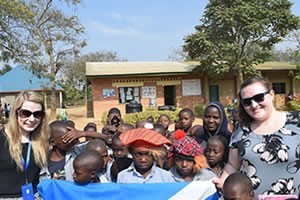This blog post was first published by GTC Scotland magazine Teaching Scotland in September 2015:
Emma Hely, a History/Modern Studies teacher at Buckie High School in Moray, talks about her eye-opening experience teaching in Rwanda.
I am not entirely sure what I was expecting before the trip. I knew that there would be culture shock and I knew it would be pretty hot but I don’t think I was prepared for the reality of life in Rwanda. It is a beautiful country and the people there are welcoming and friendly. I worked in E.S. Kamabuye ( a secondary school) and spent a lot of my time in G.S Myange (a combined nursery, primary and secondary). Both schools are 15 minutes from Nyamata, which is a town in the Bugesra region of Rwanda. The location itself was great. We had access to a regular market and a paved, concrete road to and from our schools. We travelled by local bus that cost 50p and sat between 14 and 20 people. There was enough room for 14 at a push. Twenty was definitely crowded! We had a few power cuts but nothing we couldn’t handle. Water was an issue as it was the dry season combined with a drought meaning that many had to go quite a long way to fetch water. Houses and families were hoarding 25 litre jerry cans whenever water was available, as they knew it would not last.
I lived with Hollie Shearer, an early years primary practitioner at Strathburn Primary School. We worked side by side with Cledonia, our mentor, who was an educated and strong woman. She genuinely cared for the people she worked with and was passionate about improving practice and bringing in counselling and guidance to Rwandan education. Ugandan born, she was a friend and a guide to all things Rwandan. It was through working with Cledonia that I began to really see the challenges Rwandan teachers face.
Like many teachers here in Scotland I am used to a certain level of comfort in my classroom. Our expectations are that the power will be on and our classrooms will have projectors, white boards and maybe even a SmartBoard. We all face challenges in teaching and we all feel the pressure when our learning aids falter.
The contrast to the schools in Rwanda could not be more different.
The schools do not have the luxuries we do; in fact they are often without power for large chunks of the day. The one computer I saw working in E.S Kamabuye often cut out mid-typing and the teachers just started all over again when it did come back to life. The teachers are teaching topics and lessons without the equipment we are used to using here. Science lessons occur every day without the materials to practice an experiment. Just the word of the teacher saying if you try it, it will happen. There are ICT and computing classes being taught with no computers, just the teacher writing the information on the blackboard. The challenges these teachers face are far greater than ours. They are challenges that I know I could not teach through. But they overcome them every day and keep pushing through to give the children in front of them the best education they can. To see the teachers in Rwanda teach and educate students despite these challenges was eye opening.
However, there were similarities too. The teachers were eager to try new things and wanted to improve their teaching as much as possible. They wanted to help the students in front of them the best they could. Teachers were giving up lunchtimes and free time to sit with pupils to go over any issues they may have or to help them catch up with any gaps in knowledge. In fact, the schools I worked in had specific after-school catch-up sessions to ensure girls, and other children that seemed likely to drop out or could fail, were catered for. Staff stayed behind to try and help those who needed it. Just like we do here. Teachers are still writing reports but for the 60 to 80 children they teach in class, not the 20 to 30 we teach.
Students are students no matter the location, resources or school. Younger children were playing games at playtime and were eager to greet the visitors. Teenagers were a little more laid back and many focused on exams over the visitor. The English Club at Kamabuye was the exception. The children in the club were eager to talk at any time and practice their English. The group performed role-plays for me based around scenarios, and their command of a language that is not their own was remarkable. The club had clearly worked hard on vocabulary, performance and even a few chat up lines! This was a highlight of my time in Kamabuye. The fact the students had been in school since 7 am and stayed 4 hours after home time to take part showed me their commitment and eagerness to learn.
Another great moment was when Hollie and I were working on a writing project at G.S. Myange. Not only was watching 11 to 13 year olds write a book in English that they had worked on for hours hugely satisfying, but watching them take such pride in the illustrations and hand writing was humbling. Watching them be creative and be so proud of their work was lovely. On top of this, a few of the morning primary school students had been watching and were interested in the project. They even came in to read the books from the library over and over again as if fascinated by the stories. We managed to go outside and read with them, which was a lovely spontaneous moment. We had them jumping like frogs, baa-ing like sheep and swimming like fish. When we went back inside a few of them read to me in Kinyarwanda and English from the books. It was wonderful to see them so confident, hours after school, as they proudly read to me as I had read to them. Moments like that reaffirmed why I wanted to teach.
The whole experience was eye opening. I haven’t looked at anything the same since. From the convenience of a supermarket to the luxury of a flushing toilet, I see nearly everything with a new view point. School is so different over there. From class sizes to children actively seeking further education and skills. Teachers who face huge challenges, including English and low pay, but are still committed to helping children learn and grow. I met some amazing people and worked alongside some fantastic practitioners. Inspire, Educate and Empower Rwanda is a fantastic organisation that used the entire cohort to the best of their ability. From in-school training, to training sessions for all 60 IEE mentors. This ensured it was not just the 15 schools with a visiting teacher that benefitted, but all mentors got a chance to learn from the Scottish teachers. It was a truly empowering and humbling experience and I cannot wait to put the skills and knowledge I gained to good use in my classroom and school.



